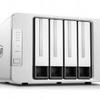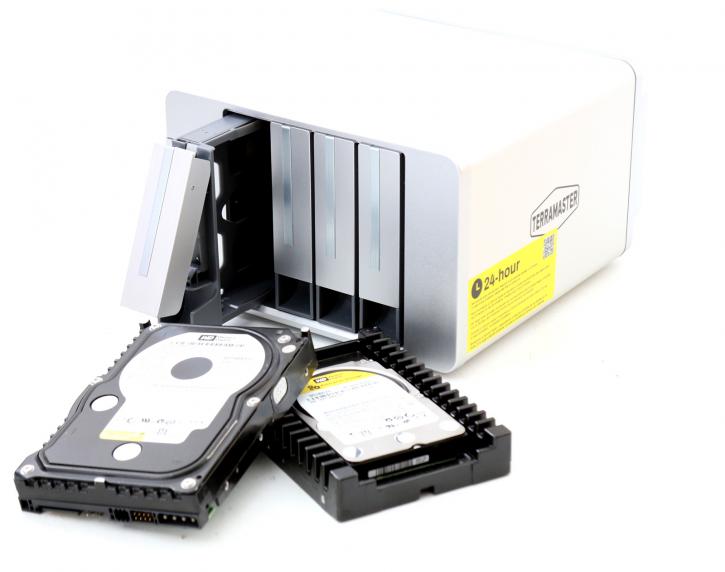NAS Explained
F4-423
The NAS can house four hard drives (or SSDs that fit in the same drive caddy). You'll get dual 2.5 GigE, meaning 2500 / 8 minus QOS and random overhead like error-correction is roughly a maximum of 275 to 290 MB/sec on a single Multi-Gigabit Ethernet connection.The processor used is the Celeron Processor N5105, which is the Jasper lake generation.
Jasper Lake
Intel 64-bit, x86 Microprocessors based on the Jasper Lake platform. The Celeron N5105 is even targeted at desktop PCs, offering a clock speed of up to 2.9GHz (single-core boost). In addition to the quad-core CPU, the SoC has a 450-800 MHz, 24 EU Intel UHD Graphics GPU, and an LPDDR4(x) dual-channel memory controller (up to 16 GB and 2933 MHz).
- Memory: 4GB DDR4
- Memory Expandable up to 32 GB (two channels)
- HDD/SSD: 4 x SATA3 6Gb/s; 3.5"/2.5"
- Maximum Internal Raw Capacity: 64 TB (Capacity may vary by RAID types)
- Expansion: USB 3.2 Gen-1 x2
- Network: 2.5 Gigabit Ethernet x 2
- Output: HDMI
- System Fan: 120mm x 1
- Power Supply Unit / Adapter: 90W x1
- Input Power Voltage: 100V to 240V AC
- Certification: FCC, CE, VCCI, BSMI, C-TICK
Bits are the basic building blocks of data storage and all computers. Computers work in binary digits, combining 0’s and 1’s in countless patterns. These binary digits are known as bits and are the smallest possible unit for data storage. So we passed the Terabyte marker years ago. With our hefty demand in storage capabilities, the industry constantly had to adapt and introduce new hardware features. Storage units increased in volume over the year; 18 TB HDDs have just been introduced onto the market with ~25 TB already in the pipeline. There is one product series growing fast in that line of storage solutions and now reaching SOHO and consumer-based markets. They are called NAS units, Network Attached Storage. And there has been a lot of development in these nifty little boxes. Pretty much, they are little servers that can hook onto your network and then function as file servers. The NAS units are often small and do not use a lot of power compared to, say, your PC, but they are highly configurable and offer redundancy as some models can even handle RAID internally. Network Attachable Storage units are among the most advanced home servers available today. Products feature multiple HDD setups, partitions, RAID, USER and user group-based access, FTP, web server, MySQL, and hot-swappable drives; these are just some of a NAS's features unit can handle. And though expensive, a product like this is just too darn handy regarding file storage and management over your network.


